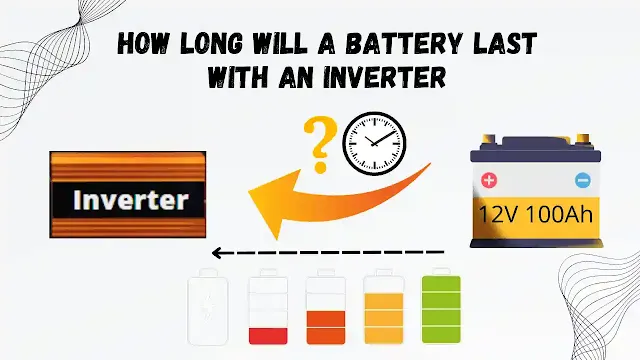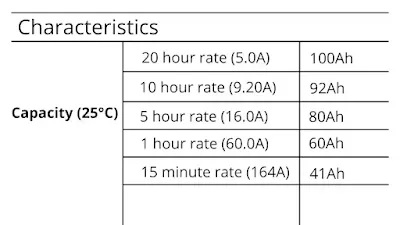How long will a battery last with an inverter

You are here because you want to know how long will a battery last with an inverter.
Although it is difficult to accurately determine the duration during of time that a battery can power an inverter due to many variables that come into play.
However, At the end of this article, you will know the average length of time a battery can power an inverter.
So, take the time to read this post carefully because you will learn important information about deep cycle batteries. It will be worth it. I promise you.
2 Key Factors of Battery Duration Time
Before we discharge a specific battery, we need to meet two important criteria:
- Current drawn from the battery
- Depth of discharge of the battery
Current drawn from the battery
The first criterion is the current drawn from the battery to the inverter, expressed as the recommended discharge rate or C-rate for the battery. This is the maximum recommended current that can be drawn from the battery relative to its nominal capacity.
A discharge rate of 1C means that the battery provides the inverter with a current (I_batt) equal to its nominal capacity.
I_batt (Amps) = C (Ah) × 1 = 1C
A discharge rate of 0.5C means that the battery provides the inverter with a current equal to half of its nominal capacity.
I_batt (Amps) = C (Ah) × 0.5 = 0.5C
For example, if you have a 12V 100Ah battery, and you discharge it at a rate of 1C, then it provides a current of 100 amps (100Ah × 1).
You might say that since the battery is discharged at 100A and its capacity is 100Ah, so it will last for one hour (=100Ah / 100A).
Yes and no, acutely the answer depends on the type of battery.
If the battery is lithium (LiFePO4) , you can expect it to last for one hour.
If the battery is lead-acid, the battery will not last for a full hour (between 20-30min).
Depth of discharge of the battery
The second criterion is the depth of discharge. We do not want to over-discharge the battery, which means exceeding the allowable discharge capacity of the battery, as continued over-discharge is very harmful to the battery's lifespan.
2 Steps to calculate how long will a battery last with an inverter
Step #1. Calculate the discharge current
Before we delve into the details, let's determine the current drawn from the battery to the inverter.
To calculate the current drawn from the battery, you need to know the total load (or the inverter's capacity in watts if you're using it at full load), the inverter's efficiency, and the battery voltage. You can use the following formula:
Current draw = Total load (W) / [Battery voltage (V) × Inverter efficiency (%)]
- Inverter efficiency: Inverters are not perfect units and lose some energy during the conversion of current from DC to AC. The efficiency of these units typically ranges from about 80% to 95%.
- Total load: add up the power of the loads connected to the inverter or use the rated output capacity of the inverter. When using the rated capacity of the inverter, you can determine the minimum runtime of the battery connected to the inverter.
Example: If you have an inverter with a capacity of 800W fully loaded (800 watts) operating at 12V, the current drawn from the battery will be:
Current draw = 800W / [12V × 0.9] = 74 Amps
Step #2. Calculate the Battery Running Time
To calculate the battery runtime for a power inverter system, we use the following formula:
Battery Running Time = Battery nominal capacity (Ah) / Current draw (Amps)
This formula can only be used if the discharge current (the current drawn from the battery) does not exceed the maximum recommended value for a long period.
The reason:
When the discharge current is exaggerated, the battery will suffer from loss of its nominal capacity due to the generation of internal heat.
The nominal capacity of the battery is the capacity measured when the battery is discharged at the maximum recommended discharge current.
The maximum recommended discharge current for a long period varies according to the battery chemistry (lead-acid or lithium).
Lead-Acid Battery:
When a lead-acid battery is discharged at the recommended c-rate or a smaller current, for example, at a rate of 0.05C (this should be checked for each battery model by referring to its datasheet), the output voltage is usually around 12 volts most of the discharge time. When its discharge current exceeds the recommended value, for example, at a rate of 1C, the battery voltage decreases over time (less than 12 volts!), leading to a loss in nominal capacity due to the strong discharge current.
 |
| Datasheet show the actual capacity of 100Ah lead-acid battery |
The actual capacity of the battery when discharged at a rate of 1C (strong current) may be less than 40-70% of the nominal capacity (at a rate of 0.05C) for lead-acid batteries.
Lithium (LiFePO4) Battery :
For lithium batteries, they are known for not suffering from capacity loss when discharged at less than 1.0C current.
However, if the inverter tries to draw a strong continuous output current, the battery's built-in Management System (BMS) will shut down the battery to protect it.
How long will a 12V battery last with an inverter
By satisfying the above-mentioned criteria, we can calculate how long will a 12V battery last with different loads connected with an inverter.
How long will a 12V battery last with a 1000 watt inverter loaded with 1000W (93% efficiency)?
- Current draw = 1000W / [12V × 0.93] = 90A
For a 12V-100Ah lithium (LiFePO4) battery (80% DOD)
Since the current to be drawn from the battery is less than 1C (=100A), we can apply the formula:
- Battery Running Time = 100 Ah / 90A = 1.1 hours ~> 67 minutes.
- Battery Running Time (80% DOD) = 1.1 hours × 0.80 = 0.9 hours ~> 54 minutes.
So, if you have a fully charged 12V 100 Ah lithium (LiFePO4) battery and you want to run an inverter loaded with 1000 W with a depth of discharge up to 80%, you can expect a runtime of 54 minutes.
For a 12V-100Ah lead-acid battery (50% DOD)
- The battery running time at high discharge current is given in the battery datasheet.
How long will a 12V battery last with an inverter loaded with 200 watts (93% efficiency)?
- The current draw = 200W / [12V × 0.93] = 16 A
For a 12V-200Ah lithium (LiFePO4) battery (80% DOD)
- Battery Running Time = 200 Ah / 16 A = 12.5 hours.
- Battery Running Time (80% DOD) = 12.5 hours × 0.80 = 10 hours
So, if a 12V 200 Ah lithium (LiFePO4) battery sustain an inverter loaded with 200 W with a depth of discharge up to 80%, you can expect a runtime of 10 hours.
For a 12V-200Ah lead-acid battery (50% DOD)
Since the current to be drawn from the battery is less than 0.2C (=20A).
- Battery Running Time ≈ 200 Ah / 16 A ≈ 12.5 hours.
- Battery Running Time (50% DOD) ≈ 1.1 hours × 0.5 ≈ 6.25 hours.
Thus, if a 12V 200 Ah lead-acid battery sustain an inverter loaded with 200 W with a depth of discharge up to 50%, you can expect a runtime of ≈ 6-6.25 hours
How long will a 24V battery last with an inverter
By satisfying the above-mentioned criteria, we can calculate how long will a 24V battery last with different loads connected with an inverter.
How long will a 24V battery last with a 1000 watt inverter loaded with 1000W (93% efficiency)?
The current drawn from the battery = 1000W / [24V × 0.93] = 45A
For a 24V-100Ah lithium (LiFePO4) battery (80% DOD)
The current to be drawn from the battery is less than 1C (=100A):
- Battery Running Time = 100 Ah / 45 A = 2.2 hours
- Battery Running Time (80% DOD) = 2.2 hours × 0.80 = 1.7 hours.
How long will a 24V battery last with a 2000 watt inverter loaded with 2000W (93% efficiency)?
The current drawn from the battery = 2000W / [24V × 93%] = 90A
For a 24V-100Ah lithium (LiFePO4) battery (80% DOD)
- Battery Running Time = 100 Ah / 90 A = 1.1 hours.
- Battery Running Time with 80% DOD = 53 minutes.
Conclusion
In short, we do not want to draw too much current from the battery to the inverter. If you plan to do so, you need to connect more batteries.
If you intend to run a load on a 12V inverter, choose a battery with a capacity of at least:
- Lithium (LiFePO4): Battery Size (Ah) = Inverter Size (W) / (12V * 1) => (Battery running time is 1 hour).
- Lead-acid: Battery Size (Ah)= Inverter Size (W) ) / (12V * 0.2) => (Battery running time is estimated between 4-5 hours).
If you plan to run a load on a 24V inverter, choose a battery with a capacity of at least:
- Lithium (LiFePO4): Battery Size (Ah) = Inverter Size (W) / (24V * 1) => (Battery running time is 1 hour).
- Lead-acid: Battery Size (Ah) = Inverter Size (W) ) / (24V * 0.2) => (Battery running time is estimated between 4-5 hours).

